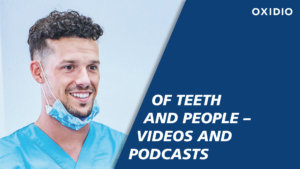We not only work hand in hand, but also share the joy of joint leisure activities. Whether at a team event, playing sports or simply getting together.
Welcome to our dental clinic

Dr. Winkelmann provides information and explains: media center with videos and podcasts.
Dr. Reinhard Winkelmann talks about health topics in videos and podcasts.
Register before your first appointment using our new online anamnesis form
Please scan the QR code with your mobile phone or use the link below.
Funny and interesting facts from the weird world of teeth.
Humans use 4 different types of teeth to cut chew and grind their food. These teeth are incisors, canine, premolars and molars.

Milk teeth start to form before you are born but only come through once the child is between 6-12months old.

The enamel on the top surface of your tooth is the hardest part of your entire body!

Humans only have 2 sets of teeth to last them their entire lifetime. Once you have all your permanent teeth make sure you look after them and brush twice a day!

Your teeth are as unique as your fingerprint, no two sets are the same.

In a lifetime your mouth will produce enough saliva to fill two swimming pools! Saliva has many uses, including assisting you with your digestion and protecting teeth from bacteria.

An average person will spend 38.5 days brushing their teeth over their lifetime.

Many diseases are linked to your oral health, including heart disease, osteoporosis and diabetes.

Only two-thirds of your tooth is visible, the other third is hidden underneath your gums.

If your tooth gets knocked out, put it in milk and hold it in your mouth, this will help the tooth to survive longer. And of course, make sure you see your dentist right away!

OVER 300 DIFFERENT SPECIES OF BACTERIA ARE FOUND IN PLAQUE.These are average numbers. You may have more, remember to brush, floss and use mouthwash to kill them!

AIRBORNE PARTICLES FROM TOILET FLUSHING CAN ACTUALLY MAKE THEIR WAY TO YOUR TOOTHBRUSH BRISTLES!Keep your toothbrushes in a drawer, or at least 6 feet from the toilet. Always replace your toothbrush every 3 months.

A WEST VIRGINIA PRISON INMATE IN 1994 BRAIDED DENTAL FLOSS INTO A ROPE TO CLIMB UP A WALL- AND SUCCESSFULLY ESCAPED! A Floss is made of nylon filament and can withstand a huge load of forces. In fact, a floss may be found handy in other uses. For example, floss can be used as a fishing line. Or maybe not.

CONTRARY TO BELIEF, DO NOT PLACE A CAP ON YOUR TOOTHBRUSH.It is actually causing bacteria to accumulate and fester within the moist environment. This could lead to potential problems for your teeth. In fact, if you are using a mouthwash, it may be a good practice to rinse the bristles of the toothbrush with the mouthwash every now and then.

DID YOU KNOW THAT 59% OF PEOPLE WOULD RATHER HAVE A DENTAL APPOINTMENT INSTEAD OF SITTING NEXT TO A PERSON THAT’S TALKING ON A CELL PHONE? Sitting next to a person that’s talking on a phone could be so annoying especially if the person is in public since they tend to be louder. Many people prefer the dental visit over this inconvenience.

THE FIRST OFFICIAL TOOTHBRUSH COMMERCIAL WAS MADE IN 1938 Are you wondering what people used to buy before 1938? The first toothpaste was introduced in 1908, which is 30 years earlier than the tooth brush. Another shocking factor, it took them 17 years to develop the first toothpaste.

IN 1948 IN CHINA, THE FIRST TOOTHBRUSH WITH BRISTLES WAS MADE BY USING HAIR FROM HORSES, HOGS, AND BADGERS.

Following the WWII, more people were inclined to commercial products. Therefore, toothbrushes were widely promoted.

DID YOU KNOW SNAIL’S MOUTH IS NO LARGER THAN A PINHEAD- BUT IT HAS MORE THAN 25,000 TEETH. Don’t be fooled by the snail’s size, snails have thousands on tiny teeth.

IN EARLY AMERICA, BLACKSMITHS WHO MADE HORSESHOES AND OTHER METAL OBJECTS OFTEN SERVED AS DENTISTS No wonder why people hate dental appointments. In fact, 80% of patients would rather do something else than going to the dentist.

MUMMIES IN EGYPT HAVE BEEN FOUND WITH FILLINGS MADE OF RESIN AND MALACHITE. GOLD WIRE WAS USED TO BIND ANY LOOSE TEETH TOGETHER.Some even say that Egyptians were the first people to work one teeth. Many examples are being pass on today.

ROMANS PLACED CAPS ON TEETH. The Romans used impressive dental technology for their time. They fixed cavity-ridden teeth with gold crowns. They also made bridges to fix gaps from missing teeth. They even had a form of toothpaste- a mix of honey and crushed eggshells.

IN MEDIEVAL GERMANY, THE ONLY BELIEVED WAY TO CURE A TOOTHACHE WAS TO KISS A DONKEY! Visiting Oxidio now days is a better option.

73% OF AMERICANS WOULD RATHER GO GROCERY SHOPPING THAN FLOSS. In fact, only 4 in 10 Americans floss routinely, and 20 percent never do. In other studies, only 12% of people admit flossing.

THE AVERAGE WOMAN SMILES ABOUT 62 TIMES PER DAY, BUT THE AVERAGE MAN SMILES ONLY 8 TIMES PER DAY! We use many muscles to smile everyday. As you will see below, you use less muscles to smile and more muscles to frown. This is our scientific explanation about the muscle mechanism of work. We will not be providing a scientific explanation about why women smile more than men.

50% OF PEOPLE SAY THAT SOMEONE’S SMILE IS THE FIRST PHYSICAL TRAIT THEY NOTICE!

THE MOST CHOKED ON OBJECT IS A TOOTHPICK. All dentist would say that the most damaging object to the the gums in between the teeth is the toothpick again. Therefore, Stop toothpicking and start flossing.

SPORTS-RELATED INJURIES ARE THE CAUSE FOR AROUND 5 MILLION MISSING TEETH EVERY YEAR! And here comes the mouthguard. Wear a mouthguard to protect your champers!

GEORGE WASHINGTON’S FAMOUS DENTURES ACTUALLY WEREN’T MADE OF WOOD. HE HAD FOUR PAIRS OF DENTURES, AND THEY WERE MADE OF GOLD, IVORY, LEAD, AND A MIXTURE OF HUMAN, DONKEY, AND HIPPO’S TEETH!l

COTTON CANDY-MAKING MACHINES WERE CO-INVENTED BY A DENTIST! AND COTTON CANDY USED TO BE CALLED “FAIRY FLOSS.” There you go, now you should start loving your dentist again.

People who drink 3 or more glasses of soda each day have 62% more tooth decay, fillings and tooth loss than others. Put down the pop and sports drinks and pick up some nice fresh water instead.

If you’re right handed, you will chew your food on your right side. If you’re left handed, you will tend to chew your food on your left side.

Every year, kids in North America spend close to half a million dollars on chewing gum.

Like fingerprints, everyone’s tongue print is different.

Kids laugh around 400 times a day, adults just 15 times a day.

Giraffes only have bottom teeth.

The most valuable tooth belonged to Sir Isaac Newton. In 1816 one of his teeth was sold in London for $3,633, or in today’s terms $35,700. The tooth was set in a ring! (source: Guinness World Records 2002).

Dogs have 42 teeth, cats have 30 teeth, pigs have 44 teeth, and an armadillo has 104 teeth.

The elephant grinds its molars and grows new ones. This happens six times in a lifetime! An elephant’s molar is about 7 inches square and can weigh over 6 pounds.

The Blue Whale is the largest mammal on earth, but it eats only tiny shrimp because it has no teeth.

The Crocodile Bird flies into the open mouth of a crocodile and cleans the crocodile’s teeth!

There are 10-12 teaspoons of sugar in a single can of soda.

In 1866, Lucy Beaman Hobbs became the first licensed female dentist.

In 1986, the winner of the National Spelling Bee won by spelling ODONTALGIA (which means toothache).

The average amount of money left by the tooth fairy in 1950 was 25 cents. In 1988 it was $1.00, the going rate now is $2.00.

The earliest dentist known by name is Hesi-Re. He lived in Egypt over 5,000 years ago.

The first toothbrushes were tree twigs. Chewing on the tips of the twigs spread out the fibers, which were then used to clean the teeth.

Ancient Greeks used pumice, talc, alabaster, coral powder or iron rust as toothpaste.

In 1905, Dental Assistant Irene Newman was trained to clean teeth. She became the first Dental Hygienist.

Inside each tooth is blood vessels and nerves.

Adults have 12 molars (including 4 wisdom teeth), 8 premolars, 4 canines and 8 incisors.

Tastebuds have a lifespan of about 10 days and take about 1 to 2 weeks to regenerate.

The tooth is the only part of the body that can’t heal itself.

Some Central American countries fashion jewelry from lost baby teeth, a tradition said to originate from ancient Viking customs where articles belonging to children were regarded as powerful, good luck, and sometimes carried into battle.

The children of the Yellowknives Dene First Nation tribe of Canada give lost teeth to their mother or grandmother, who place the tooth in a tree. The family then dances around the tree together to encourage the tooth to grow in as straight as the trunk.

Throughout Central Asia, baby teeth might be put into fat and fed to a dog with the wish that the child’s replacement tooth will be as strong as the dog’s. If there is no dog available, the teeth are buried near a tree so that the new tooth will have strong roots. Some Alaskan tribes also feed baby teeth to a dog with similar intentions.

In Greece, Vietnam, Singapore, India, Sri Lanka, and China, children throw their baby teeth on the roof when they fall out. Kids in Greece wait for a mouse or pig to retrieve it, young Sri Lankans await a squirrel, while in India, anticipation is for the return of a sparrow bearing a new tooth.

Cherokee Indian children throw the tooth on the roof, repeating, “Beaver, put a new tooth in my jaw!” four times.

Did you know the Tooth Fairy that American kids grow up with originated in 17th-century France?

Kids in Mexico and Spain expect the Tooth Mouse to come and take their baby teeth from under their pillows.

Afghanistan – the child drop the lost tooth down a mouse hole to receive a strong, new tooth like a mouse’s.

Argentina – children put their tooth in a glass of water for the Tooth Mouse.

Austria – the tooth is made into a key ring, or thrown under the house.

Bhutan – the tooth is thrown on the roof as an offering to the moon goddess.

Brazil – the tooth is thrown on the roof, so it can turn into gold.

Cambodia – the child throws the tooth into the sky so the fairies can bring them a new one.

China – upper teeth are placed at the foot of the child’s bed and lower teeth are thrown onto the roof to encourage the permanent teeth to grow faster.

Colombia – parents may dip the tooth in silver or gold to be worn as an earring.

Egypt – the child wraps the tooth in tissue and throws it to the sun, saying the words “Shiny sun, shiny sun, take this buffalo’s tooth and bring me a bride’s tooth,” so that Ra, the sun god, will give them a new one in exchange.

El Salvador – the tooth is put under the pillow, and a little rabbit brings the child money.

France – in exchange for the tooth, the tooth mouse (La Petite Souris) leaves small toys under the pillow.

India – the tooth is thrown on the roof, and the child asks a sparrow to take it away and bring them a new one.

raq – the tooth is thrown up into the sky, back to Allah.

Italy – both the Tooth Fairy and the Tooth Mouse may collect baby teeth in exchange for a present.

Japan – bottom teeth are thrown onto the roof, and top teeth are thrown under the house, to encourage them to grow straight, healthy, and strong.

Lesotho – the tooth is thrown onto the roof of the home, so a lizard can bring the child a new tooth.

Mongolia – the tooth is covered in meat fat and fed to a young dog, so the dog can bring to bring a strong new tooth (because dogs have strong teeth and can eat bones).

North Korea – the child throws the tooth in the air, and a black bird comes and takes it away in exchange for a new, white tooth.

Nigeria – one of several native traditions is that the child draws 7 circles in a straight line on the ground, and then dances in each circle. Dancing well helps the teeth grow in straight; if you dance badly, they’ll grow crooked.

Romania – the tooth is thrown over the roof of the house, and the child says “Crow, crow, take away this bone tooth and bring me a steel one!”

Scotland – in the lowlands, a white fairy rat purchases lost teeth in exchange for coins.

South Korea – the child throws the tooth in the air while singing a song, asking the birds to take the old tooth in exchange for a new one.

Sudan – the tooth is thrown to the sun, and the child says “take this donkey’s tooth and replace it with a beautiful gazelle’s tooth!”

Swaziland – the child puts the tooth in a shoe, and by morning it will be replaced by candy.

Throughout history, poor people have sold their teeth for money.

The teeth of fallen soldiers.

The ancient Romans whitened their teeth using stale urine. Urine contains ammonia, which Romans used to clean and whiten their teeth. The ammonia acted as a bleaching agent and was allegedly very effective!

There’s a statue in Mexico called the “Lord of Patience”, which is fitted with real human teeth.

Humans didn’t struggle with the issue of crooked teeth until agriculture came into existence. As farming became the new normal for Homo sapiens, and we did away with hunter-gathering, our diets changed to include softer foods that required less chewing. Scientists have theorised that as a result, our jaws were altered over time and became shorter and wider. Unfortunately, our teeth didn’t evolve along with our jaw, which basically means there is now less room in a human mouth for teeth, and that’s why they can get crowded and become displaced.

The oldest known filling in the world is 6,500 years old and is made of beeswax. The filling belongs to a 24 to 30-year-old Neolithic man. Scientists noticed that a vertical crack in one of his teeth had been fitted with a perfectly sized thin cap of beeswax, suggesting that Neolithic humans may have used the material to fill their cavities regularly while they were alive.

Way before humans came up with writing systems, or even the wheel, they would drill rotten teeth to correct tooth decay. There’s evidence that 14,000 years ago, humans removed decayed dental tissue using primitive tools. 5,000 years later, the first dental drill is believed to have been used in what is now Pakistan. The discovery was made in a Neolithic graveyard where at least nine individuals evidenced use of a dental drill due to the precise holes in their molars.

During the American Civil War, soldiers needed to have at least four opposing front teeth so they could tear open a gunpowder pouch on the battlefield. Some draftees would have their front teeth removed so as to avoid service.

In The Hangover, no effects or prosthetic were used for Stu’s missing tooth – Ed Helms actually has a fake incisor which he took out. One of Ed’s adult teeth never came through – which is actually quite common – and he had an implant fitted at age 16. To film the parts of the movie where one of Stu’s front teeth is missing, Ed had his dentist remove his implant in order to save using prosthetics or blacking out a tooth.

During an expedition to Antarctica in July 1911, explorer Apsley Cherry-Garrard’s teeth chattered so violently that they actually shattered. Cherry was there to collect emperor penguin eggs with his colleagues Henry Bowers, Bill Wilson, and Robert Scott. To reach the emperor penguin colony, the men had to endure a severe Antarctic midwinter, in which temperatures plunge to -60°C. Three of them lost their lives, and only Cherry survived to tell the tale.

World-famous author Roald Dahl had all of his teeth removed at 21 years old because he thought they were more trouble than they were worth. He would also go around evangelising about having all your teeth pulled out and replaced with false ones! I’m not not against it.

Sharks grow their teeth back over and over again. Sharks are continually growing new teeth – when an older one wears out, it simply falls out onto the ocean floor and a new one grows in its place. Over its lifetime, the average shark will produce 20,000-40,000 teeth.

Naked mole rats can move their incisors (front teeth) independently, kinda like chopsticks.These rodents use their teeth for carrying things, digging, fighting, grooming, and of course, eating.

Cats need taurine in their diet or else they may lose their teeth, fur, and eyesight. Taurine is an amino acid that naturally occurs in the human body as well as in many foods such as meat, fish, and dairy. It’s often added to energy drinks because it improves physical performance.

A tooth that has been knocked out can sometimes be saved if it is jammed back into the empty socket immediately. Remember that episode of Friends where Monica cuts off Chandler’s toe? Well, this is just like that! If your tooth is knocked out, you should wash it off in water and try to reinstall it in your mouth. Gently push it into the socket, making sure you only touch the crown and not the root, and close your mouth to hold it in place. If your tooth is knocked out, please seek professional medical advice immediately.

The amount of fluoride in a tube of toothpaste can actually be fatal to children. Depending on the age and weight of a child, ingesting a certain amount of toothpaste can cause severe poisoning. That’s why it’s important for kids to spit out fluoride toothpaste after they’re done brushing!

Mayans would bejewel their teeth using early drills. Mayan kings and queens would have minute holes drilled into their teeth with tiny pieces of jade placed in them. Jade was a precious stone to the ancient Mayan – it signified nature, growth, and sustenance. Rulers used it to tell their people that they could be trusted to nurture and take care of them. The wealthy non-ruling class would also modify their teeth for aesthetic purposes, but this would be done with more affordable jewels.


We are looking to expand our team at Oxidio!
Oxidio is looking for an enthusiastic dental assistants. We would like to find a team player who is dedicated to taking care of the needs of our patients and can assist our doctors in array of procedures.

Make an appointment
and get in touch
We would be pleased to welcome you in our dental clinic.
Pictures and videos from all over the world. Follow us on our colorful Instagram channel.
OXIDIO
Lukas E. Winkelmann, DMD
Bluecherstrasse 13
71116 Gaertringen
CONTACT
Phone: 07034 6477290
Fax: 07034 64772964
E-Mail: praxis@oxidio.de
OPENING HOURS
| Mo, Tu: | 07:00 am – 12:00 pm |
| 12:30 pm – 4:00 pm | |
| We, Th: | 08:00 am – 12:00 pm |
| 12:30 pm – 5:00 pm | |
| Fr: | 07:00 am – 12:00 pm |




